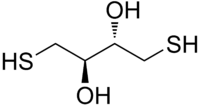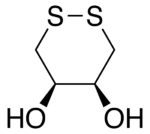Dithioerythritol
 | |
| Names | |
|---|---|
| Preferred IUPAC name
(2R,3S)-1,4-Bis(sulfanyl)butane-2,3-diol | |
| Other names
(2R,3S)-1,4-Dimercaptobutane-2,3-diol (no longer recommended) 2,3-Dihydroxybutane-1,4-dithiol Erythro-2,3-dihydroxy-1,4-butanedithiol Erythro-1,4-dimercapto-2,3-butanediol Cleland's reagent (also used for DTT) | |
| Identifiers | |
| 6892-68-8 | |
| 3D model (Jmol) | Interactive image Interactive image |
| ChEBI | CHEBI:17456 |
| ChemSpider | 388475 |
| ECHA InfoCard | 100.027.271 |
| PubChem | 439352 |
| |
| |
| Properties | |
| C4H10O2S2 | |
| Molar mass | 154.253 g/mol |
| Melting point | 82 to 84 °C (180 to 183 °F; 355 to 357 K) |
| Except where otherwise noted, data are given for materials in their standard state (at 25 °C [77 °F], 100 kPa). | |
| | |
| Infobox references | |
Dithioerythritol (DTE) is a sulfur containing sugar derived from the corresponding 4-carbon monosaccharide erythrose. It is an epimer of dithiothreitol (DTT). The molecular formula for DTE is C4H10O2S2.
Like DTT, DTE makes an excellent reducing agent, although its standard reduction potential is not quite as negative, i.e., DTE is slightly less effective at reducing than DTT, presumably because steric repulsion of its OH groups makes the cyclic disulfide-bonded form of DTE less stable compared to that of DTT. In DTT, these hydroxyl groups are trans to each other, whereas they are cis to each other in DTE.


The oxidized forms of dithioerythritol (DTE, left) dithiothreitol (DTT, right)
References
- Cleland, W.W. (April 1964). "Dithiothreitol, A New Protective Reagent for SH Groups". Biochemistry. 3 (4): 480–2. doi:10.1021/bi00892a002. PMID 14192894.
This article is issued from Wikipedia - version of the 9/16/2016. The text is available under the Creative Commons Attribution/Share Alike but additional terms may apply for the media files.